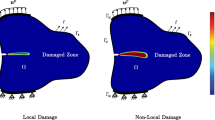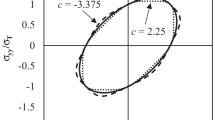Abstract
The stress, strain, displacement and damage fields near the tip of a crack in a power-law hardening material with continuous damage formation under antiplane longitudinal shear loading are investigated analytically. The interaction between a major crack and distributed microscopic damage is considered by describing the effect of damage in terms of a damage variable D. A deformation plasticity theory coupled with damage and a damage evolution law are formulated. A hodograph transformation is employed to determine the singularity and angular distribution of the crack-tip quantities. Consequently, analytical solutions for the antiplane shear crack-tip fields are obtained. Effects of the hardening exponent n and the damage exponent m on the crack-tip fields are discussed. It is found that the present crack-tip stress and strain solutions for damaged nonlinear material are similar to the well-known HRR fields for virgin materials. However, damage leads to a weaker singularity of stress, and to a stronger singularity of strain compared to that for virgin materials, respectively. The stress associated with damage always falls below the HRR field for virgin material; but the distribution of strain associated with damage lies slightly above the HRR field for r/(J/τ0) > 1.5 while the difference becomes negligible when r/(J/τ0) > 2. The limiting distributions of stress and strain may indeed be given by the HRR field.
Similar content being viewed by others
References
A.S. Argon, J. Im and R. Safogln, Cavity formation from inclusion in ductile fracture. Metallurgical Transactions 6A (1975) 825–837.
J.W. Hancock and A.C. Machenzie, On the mechanisms of ductile failure in high-strength steels subiected to multi-axial stress-state. Journal of the Mechanics and Physics of Solids 24 (1976) 147–169.
J.W. Hancock and M.J. Cowling, Role of state of stress in crack-tip failure processes. Metal Science 14 (1980) 293–304.
F.B. Beremin, Cavity formation from inclusions in ductile fracture of A508 steel. Metallurgical Transactions 12A (1981) 723–732.
B. Marini, F. Mudry and A. Pineau, Study of cavity growth in ductile rupture of A508 steel under nonradial loading. Engineering Fracture Mechanics 22 (1985) 375–386.
B. Marini, F. Mudry and A. Pineau, Study of cavity growth in ductile rupture of A508 steel under nonradial loading. Engineering Fracture Mechanics, 22 (1985) 989–996.
R.O. Ritchie and A.W. Thompson, On macroscopic and microscopic analyses for crack initiation and crack growth toughness in ductile alloys. Metallurgical Transactions 16A (1985) 233–248.
H. Miyamoto, K. Machida, H. Okaysu and T. Kawazoe, Study of the process zone at the crack tip (behavior of the voids at the crack tip of aluminum alloy specimen) in, Mechanical Behaviour of Materials-V, ICM-5, M.G. Yan et al. (eds.), Vol. 1, Pergamon Press, Oxford (1987) 39–50.
J.F. Knott, Effects of microstructure and stress-state in ductile fracture research in, Advances in Fracture Research, ICF7, K. Salama et al. (eds.), Vol. 1, Pergamon Press, Oxford (1989) 125–138.
S.-X. Wu, B. Cotterell and Y.-W. Mai, On the relationship between crack tip opening displacement at the initiation of a ductile tear in low alloy steel, hydrostatic stress, and void growth. International Journal of Fracture 51 (1991) 207–218.
T.J. Wang, Thermal and mechanical load induced damage behaviour of a low alloy steel: mechanisms and modelling. Engineering Fracture Mechanics 44 (1993) 971–980.
T.J. Wang, Thermal and mechanical load induced damage behaviour of a low alloy steel: mechanisms and modelling. Engineering Fracture Mechanics 45 (1993) 799–812.
J.R. Rice and G.F. Rosengren, Plane strain deformation near a crack tip in power-law hardening material. Journal of the Mechanics and Physics of Solids 16 (1968) 1–12.
J.W. Hutchinson, Singular behaviour at the end of a tensile crack in hardening material. Journal of the Mechanics and Physics of Solids 16 (1968) 13–31.
J.R. Rice, Stresses due to a sharp notch in a work-hardening elastic-plastic material loaded by longitudinal shear. ASME Journal of Applied Mechanics 34 (1967) 287–298.
J.C. Amazigo, Fully plastic crack in an infinite body under anti-plane shear. International Journal of Solids and Structures 10 (1974) 1003–1015.
C.F. Shih, Journal of the Mechanics and Physics of Solids 29 (1981) 305–326.
J.W. Huchinson, Crack tip singularity fields in nonlinear fracture mechanics: a survey of current status in, Advances in Fracture Research. ICF5, D. Francois et al. (eds.), Vol. 6, Pergamon Press, Oxford (1981) 2669–2684.
K.C. Hwang, S.W. Yu and W. Yang, Theoretical study of crack-tip singularity fields in China. Applied Mechanics Review 13 (1990) 19–33.
Y.C. Li and T.C. Wang, High order asymptotic field of tensile plane strain nonlinear crack problems. Scientia Sinica 29A (1986) 941–955.
F.Z. Li, A. Needleman and C.F. Shih, Characterization of crack tip stress and deformation fields in creeping solids. International Journal of Fracture 36 (1988) 163–186.
N.P. O'Dowd and C.F. Shih, Family of crack-tip fields characterized by a triaxiality parameter-1. Structure of fields. Journal of the Mechanics and Physics of Solids 39 (1991) 989–1015.
N.P. O'Dowd and C.F. Shih, Family of crack-tip fields characterized by a triaxiality parameter-1. Structure of fields. Journal of the Mechanics and Physics of Solids II 40 (1992) 939–963.
A.M. Al-Ani and J.W. Hancock, J-dominance of short cracks in tension and bending. Journal of the Mechanics and Physics of Solids 39 (1991) 23–43.
C. Betegon and J.W. Hancock, Two-parameter characterization of elastic-plastic crack-tip fields. ASME Journal of Applied Mechanics 58 (1991) 104–113.
F.S. Ma and Z.B. Kuang, Elastic-plastic fracture analysis of finite bodies-I. Description of the stress field. Engineering Fracture Mechanics 48 (1994) 227–737.
F.S. Ma and Z.B. Kuang, Elastic-plastic fracture analysis of finite bodies-I. Description of the stress field. Engineering Fracture Mechanics II 48 (1994) 739–744.
S.M. Sharma and N. Aravas, Determination of higher-order terms in asymptotic elastoplastic crack tip solutions. Journal of the Mechanics and Physics of Solids 39 (1991) 1043–1072.
L.M. Kachanov, Time of the rupture process under creep conditions. Izvestiya Akademii Nauk. SSR. Otd. Tekh. 8 (1958) 26–31.
Y.N. Robotnov, Creep Problems in Structural Members. North-Holland, Amsterdam (1969).
J.L. Chaboche, Continuum damage mechanics: a tool to describe phenomena before crack initiation. Nuclear Engineering and Design 64 (1981) 233–247.
J. Lemaitre, How to use damage mechanics. Nuclear Engineering and Design 80 (1984) 233–246.
J. Lemaitre, A continuum damage mechanics model for ductile fracture. ASME Journal of Engineering Materials and Technology 107 (1985) 83–89.
J. Lemaitre, Micromechanics of crack initiation. International Journal of Fracture 42 (1990) 87–99.
D. Krajcinovic, Continuum damage mechanics. Applied Mechanics Review 37 (1984) 1–6.
D. Krajcinovic, Damage mechanics. Mechanics of Materials 8 (1989) 117–197.
S. Murakami, Notion of continuum damage mechanics and its application to anisotropic creep damage theory. ASME Journal of Engineering Materials and Technology 105 (1983) 99–105.
J.L. Chaboche, Continum damage mechanics, Part I. General concepts. ASME Journal of Applied Mechanics 55 (1988) 59–65.
J.L. Chaboche, Continum damage mechanics, Part I. General concepts. ASME Journal of Applied Mechanics II 55 (1988) 66–72.
J. Lemaitre and J.L. Chaboche, Mechanics of Solid Materials. Cambridge University Press, Cambridge (1990).
J. Hult, Introduction and general overview in, Continum Damage Mechanics: Theory and Applications, D. Krajcinovic and J. Lemaitre (eds.), Springer-Verlag, Berlin (1987) 1–36.
J.L. Chaboche, Fracture mechanics and damage mechanics in, Numerical Methods in Fracture Mechanics, Proceedings, 4th International Conference, A.R. Luxmore et al. (eds.), Pineridge Press, Swansea (1987) 309–324.
C.L. Chow and J. Wang, Ductile fracture characterization with an anisotropic continuum damage theory. Engineering Fracture Mechanics (1988) 547–563.
C.L. Chow and J. Wang, An anisotropic theory of elasticity for continuum damage mechanics. International Journal of Fracture 33 (1987) 3–16.
T.J. Wang, Unified CDM model and local criterion for ductile fracture-I. Engineering Fracture Mechanics 42 (1992) 177–182.
T.J. Wang, Unified CDM model and local criterion for ductile fracture-I. Engineering Fracture Mechanics II 42 (1992) 185–192.
T.J. Wang, Unified CDM model and local criterion for ductile fracture-I. Engineering Fracture Mechanics 48 (1994) 217–230.
J. Janson, Dugdale-crack in material with continuous damage formation. Engineering Fracture Mechanics 9 (1973) 891–899.
J. Janson, Dugdale-crack in material with continuous damage formation. Engineering Fracture Mechanics 10 (1978) 795–806.
H.D. Bui and Eh Ehrlacher, Propagation of damage in elastic and plastic solids. in, Advances in Fracture Research, ICF5, D. Francois et al. (eds.), Vol. 1, Pergamon Press, Oxford (1981) 533–551.
Q.H. Tang and T.C. Wang, The stress field near a crack-tip for damaged materials. Acta Mechanica Sinica 19 (1987) 333–341 (in Chinese).
G. Rousselier, Finite deformation constitutive relations including ductile fracture damage in, Proceedings of IUTAM Symposium on Three-Dimensional Constitutive Relations and Ductile Fracture (S. Nemat-Nasser (ed.), North-Holland, Amsterdam (1981) 331–355.
T.H. Hao, X.T. Zhang and K.C. Hwang, The antiplane shear field for crack in infinite slab of an elasto-damaged material. Acta Mechanica Sinica 23 (1991) 571–580 (in Chinese).
Z.H. Jin, S.W. Yu and K.C. Hwang, The near crack-tip fields of brittle damaged materials. Acta Mechanica Sinica (English edition) 5 (1989) 227–236.
J. Masars and J. Lemaitre, Application of continuous damage mechanics to strain and fracture behaviour of concrete. NATO ARW, Proceedings NATO Advanced Research Workshop on Application of Fracture Mechanics to Cementitious Composites, S.P. Shah (ed.), Nijhoff (1985).
Z.H. Jin and S.W. Yu, The near crack-tip field of stress and damage for concrete. Acta Mechanica Solida Sinica 11 (1990) 209–216 (in Chinese).
J. Wang and C.L. Chow, HRR fields for damaged materials. International Journal of Fracture 54 (1992) 165–183.
X.T. Zhang, K.C. Huang and T.H. Hao, Asymptotic solution of mode-III crack in damaged softening materials. International Journal of Fracture 62 (1993) 269–281.
Author information
Authors and Affiliations
Rights and permissions
About this article
Cite this article
Wang, TJ., Kuang, ZB. Stress, deformation and damage fields near the tip of a crack in a damaged nonlinear material. Int J Fract 79, 1–26 (1996). https://doi.org/10.1007/BF00017710
Received:
Accepted:
Issue Date:
DOI: https://doi.org/10.1007/BF00017710




